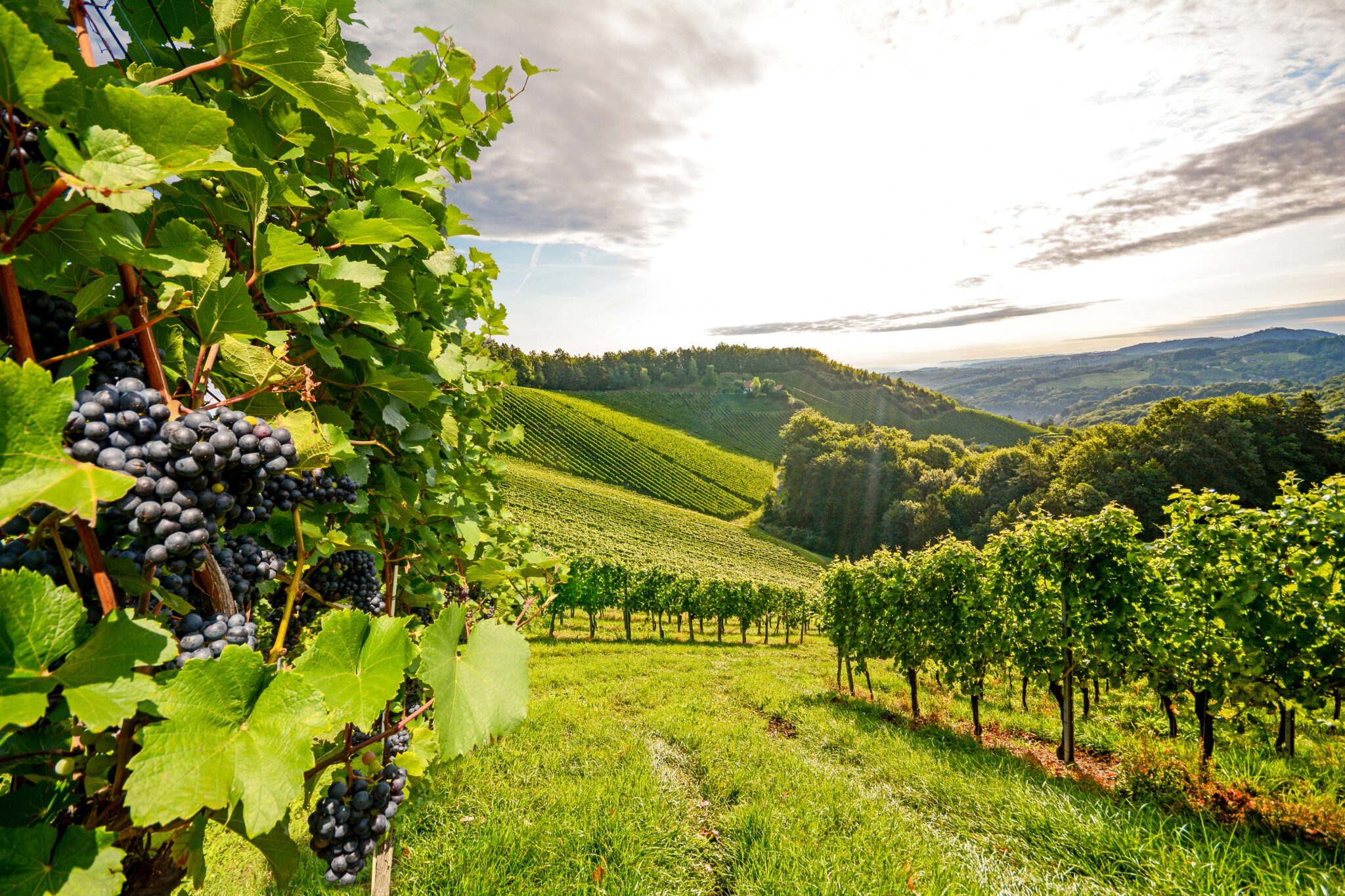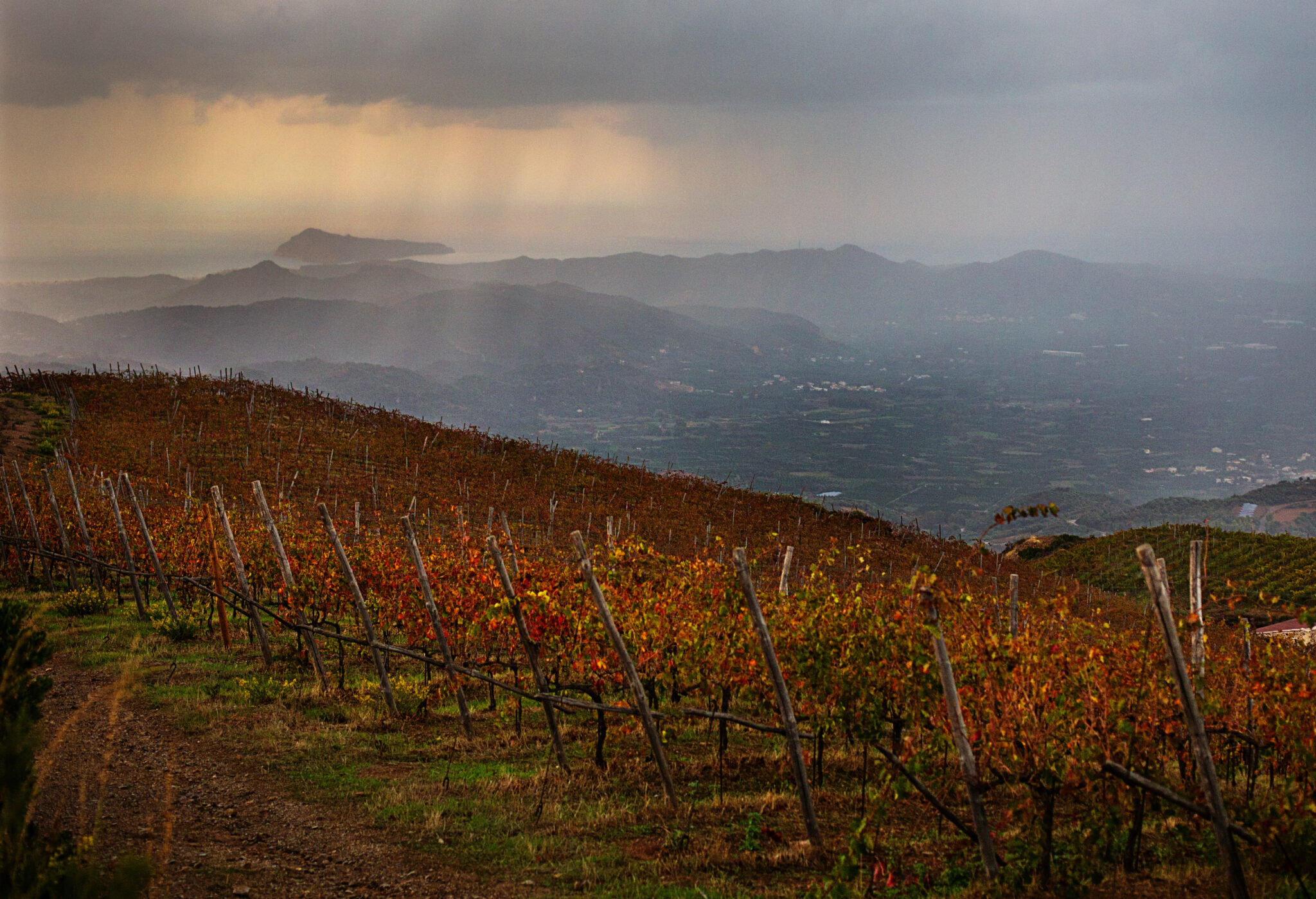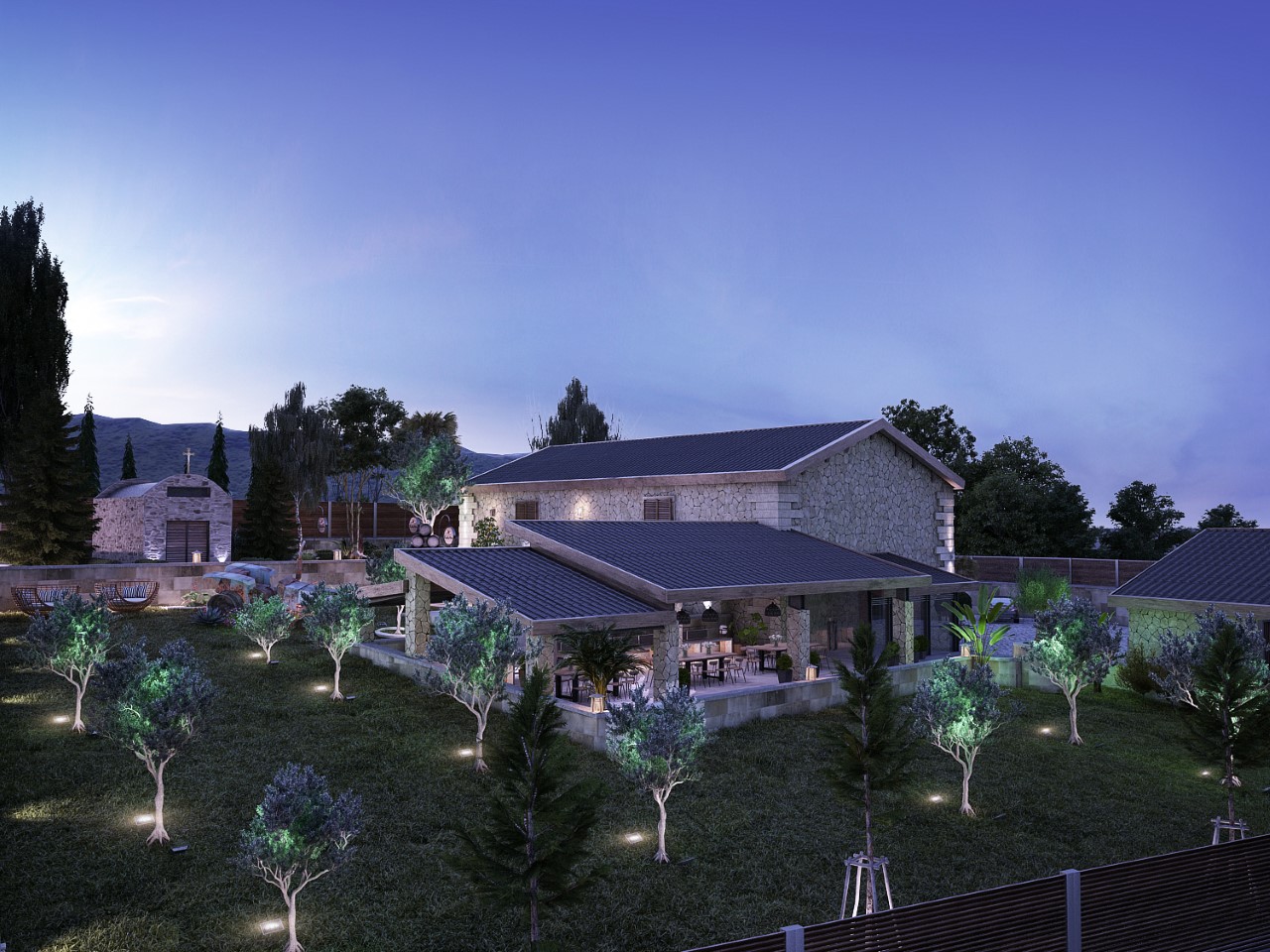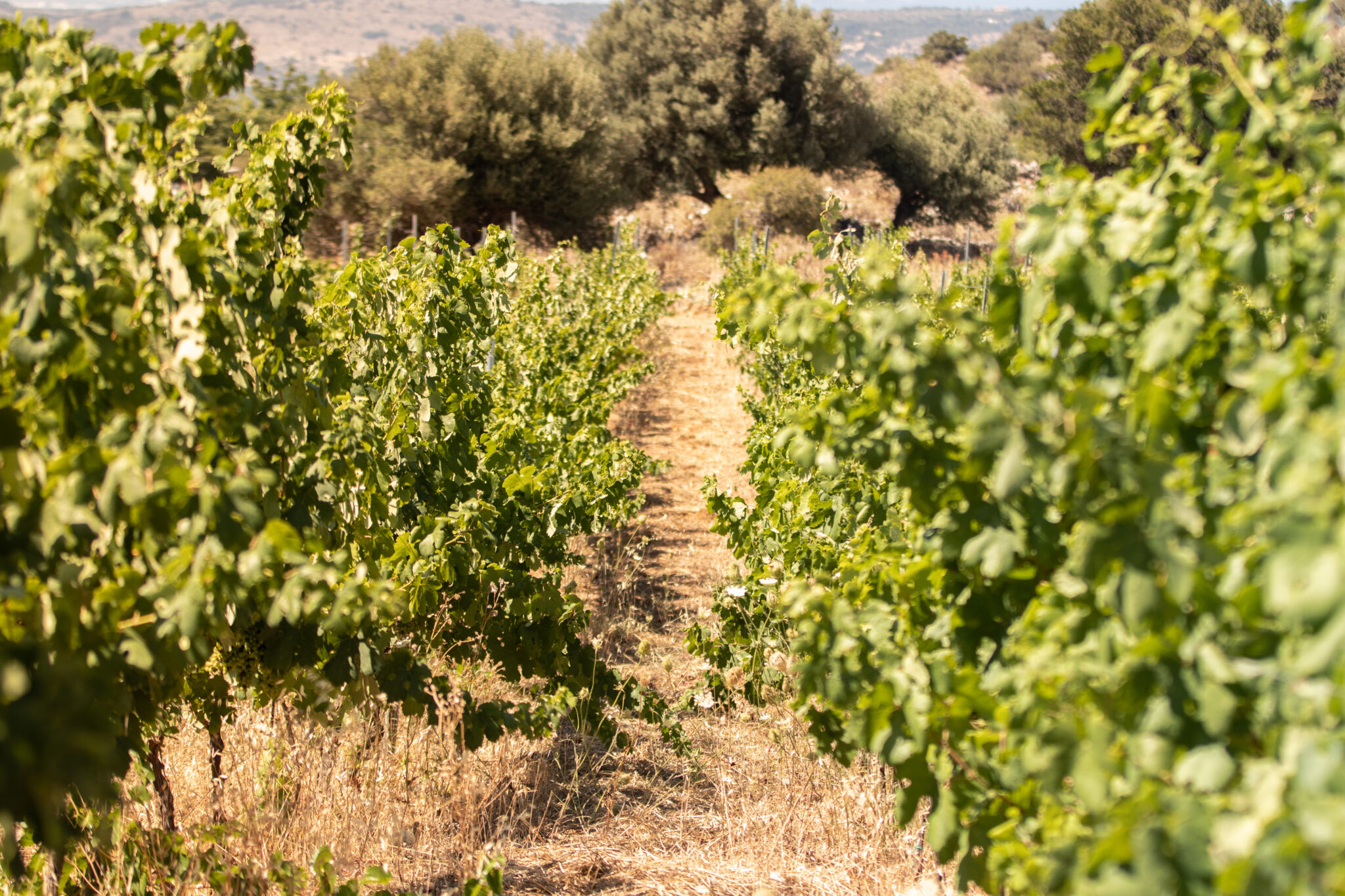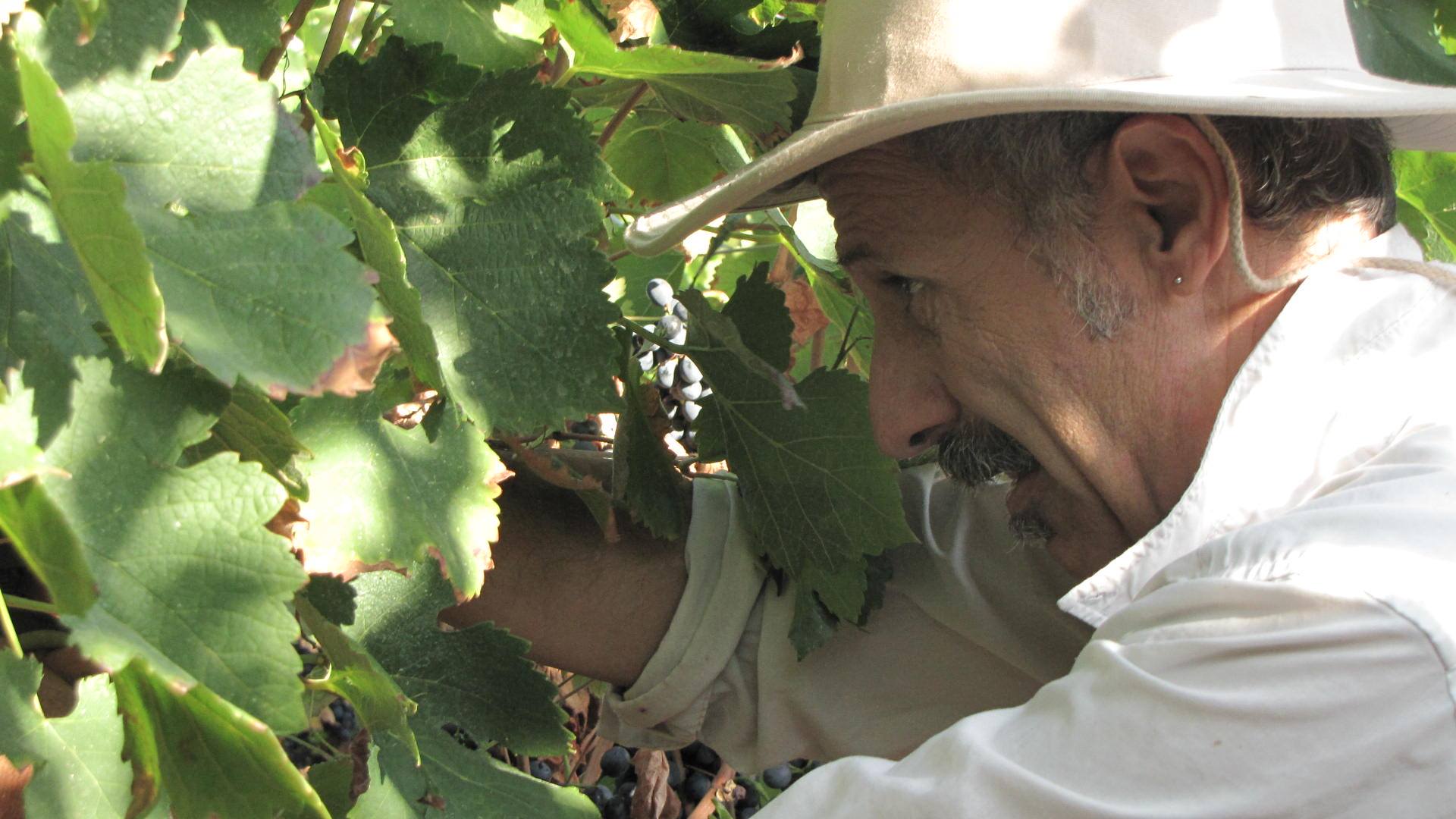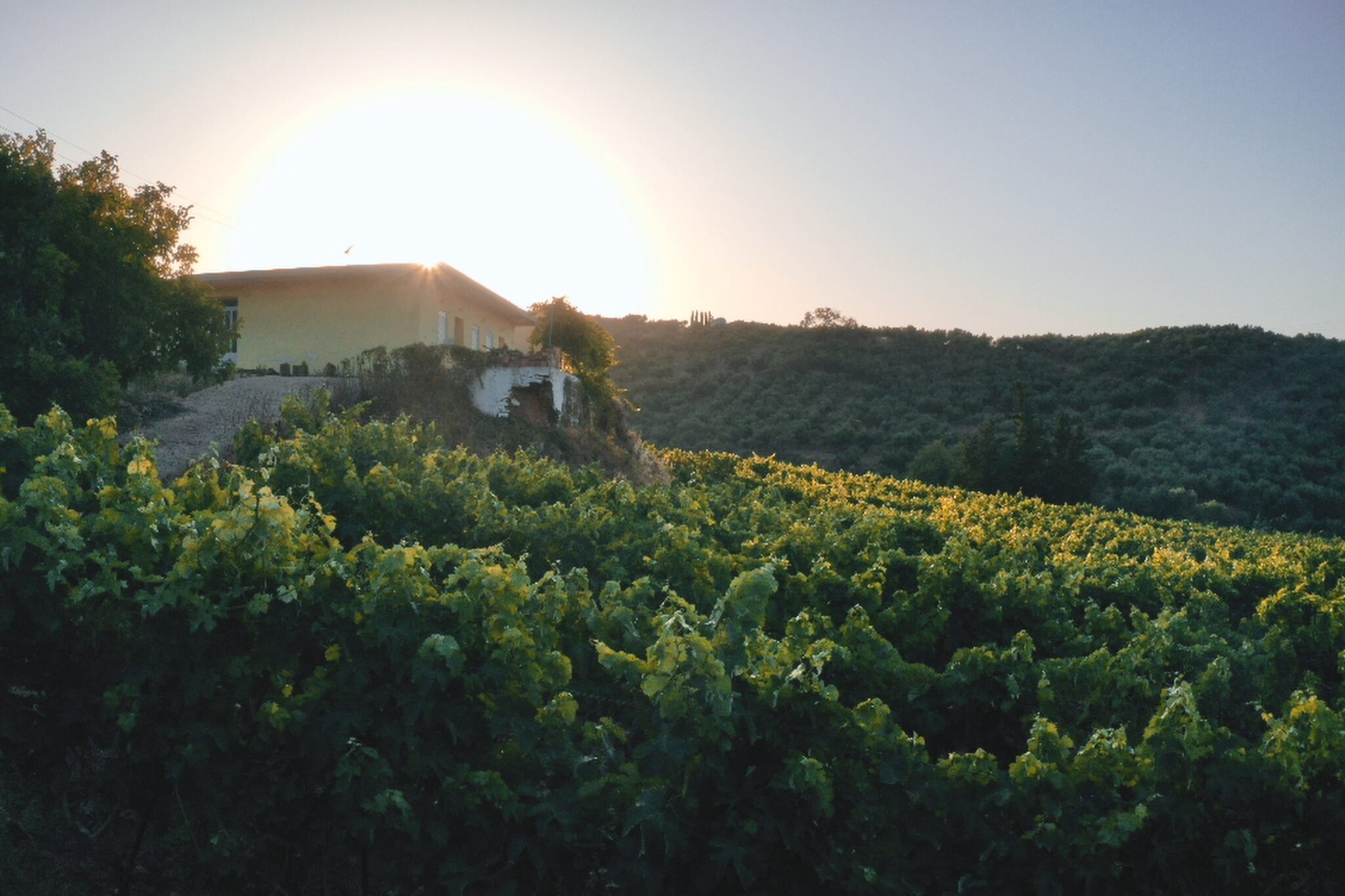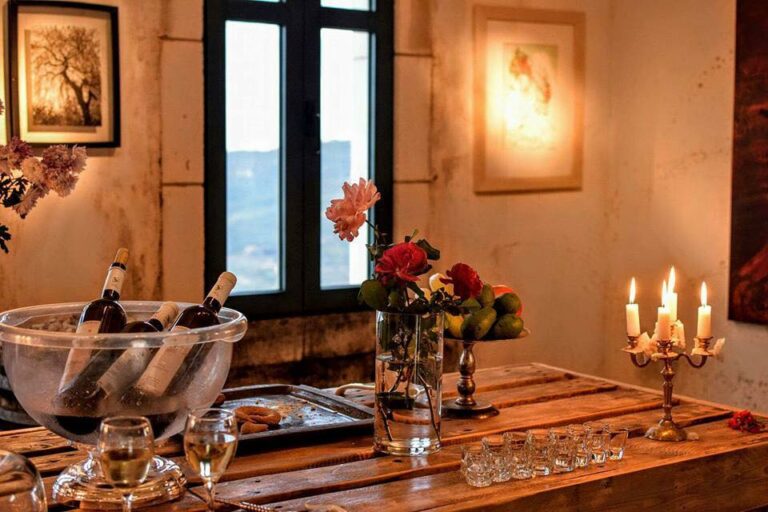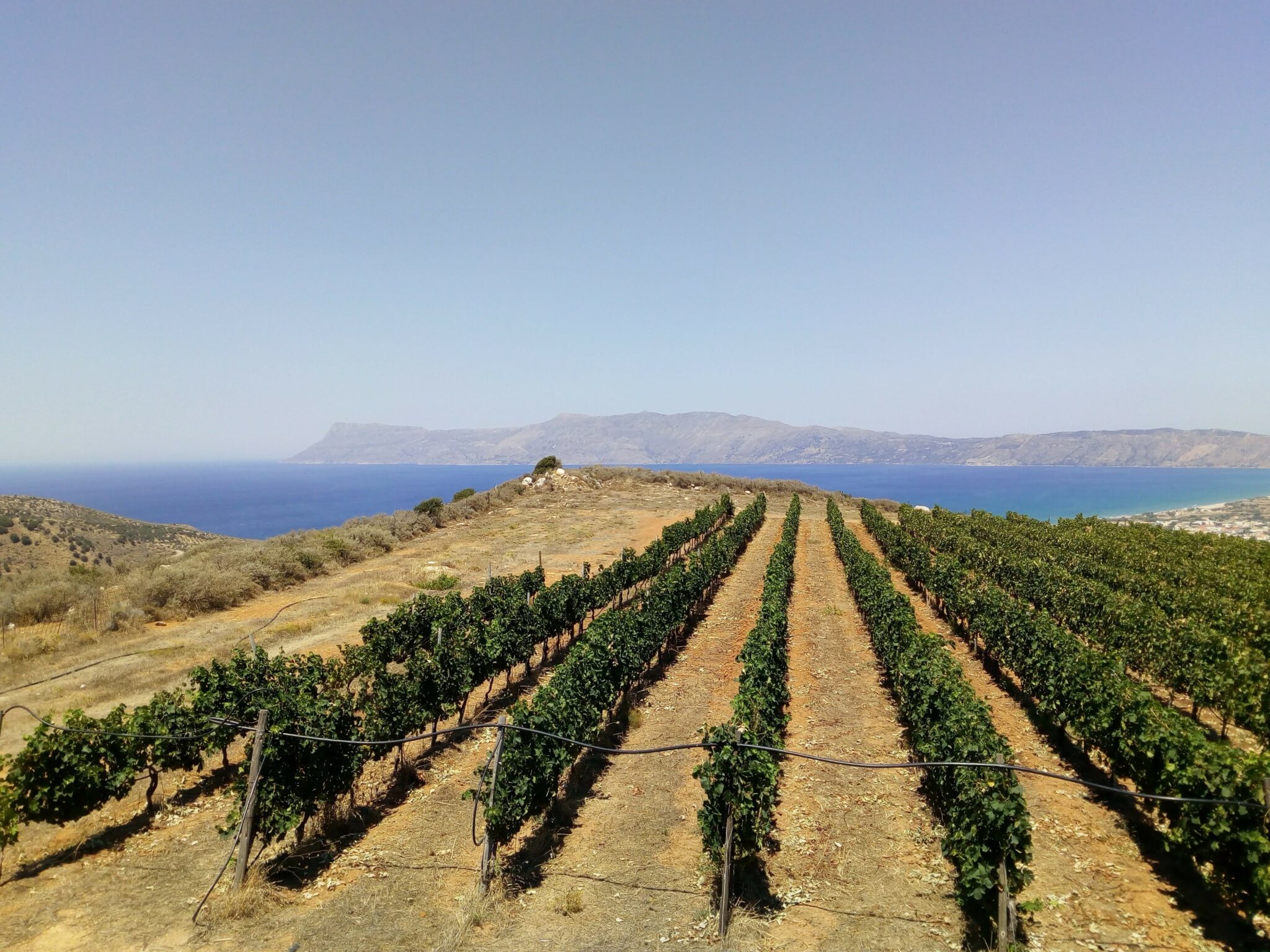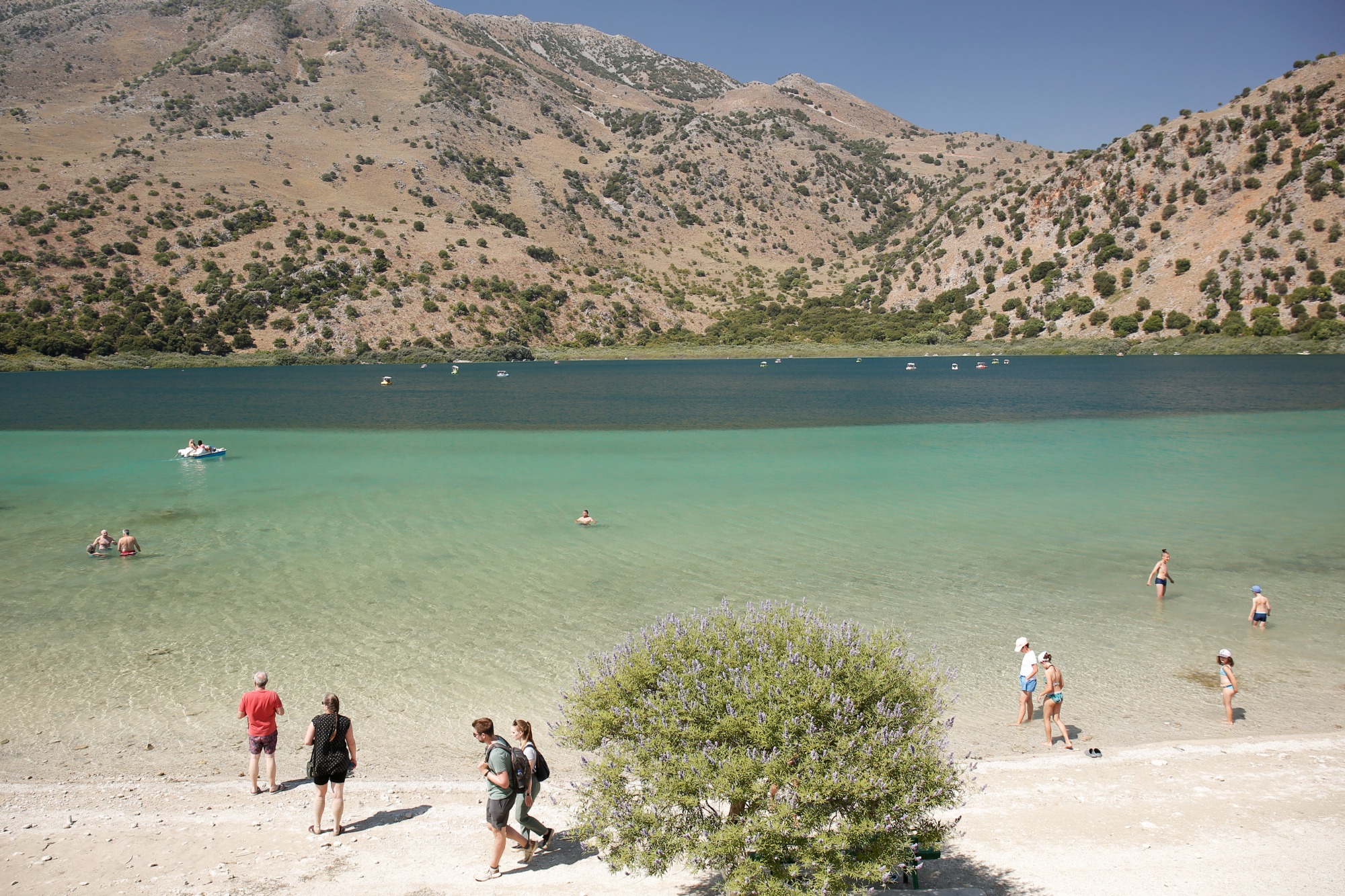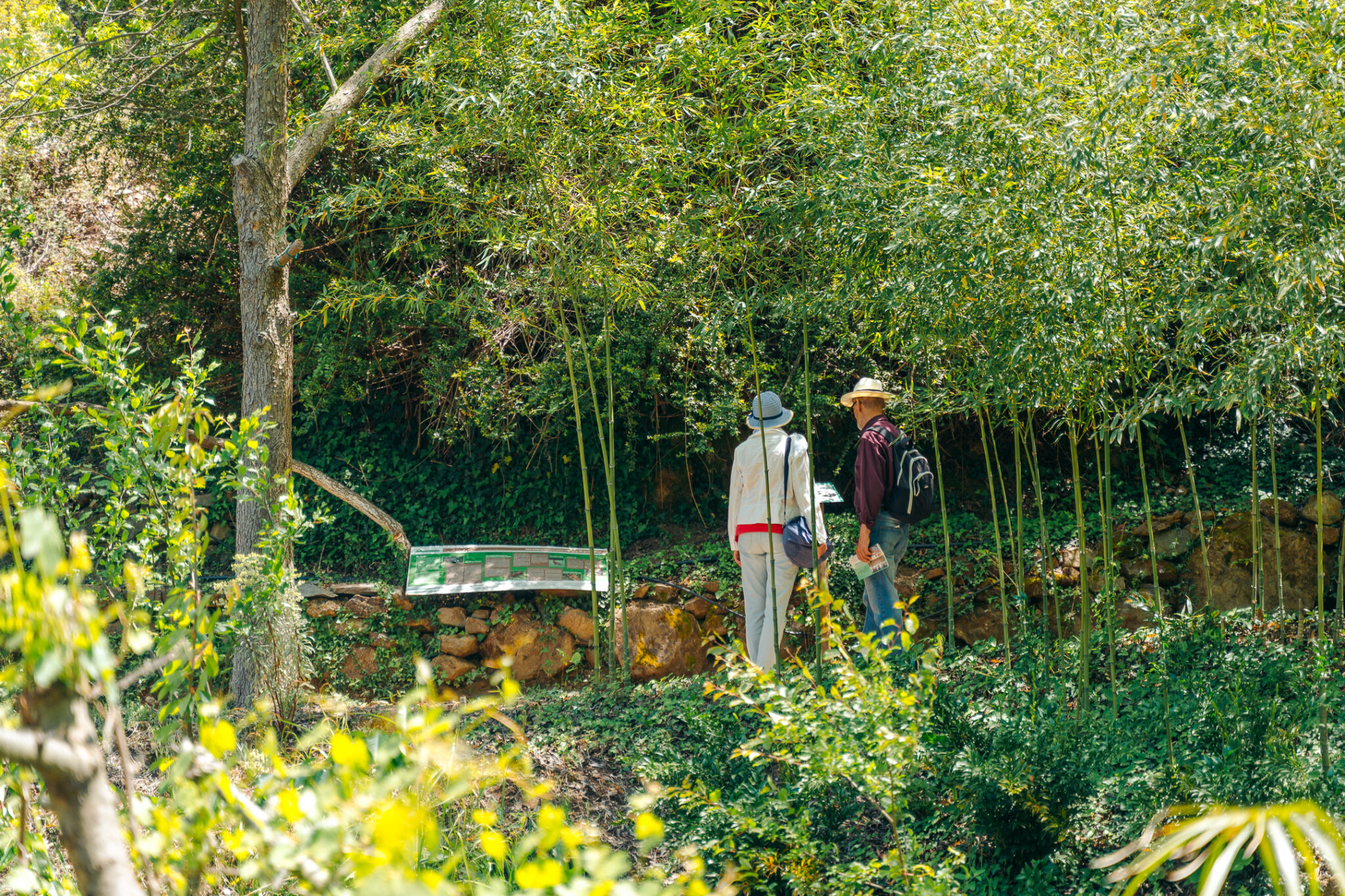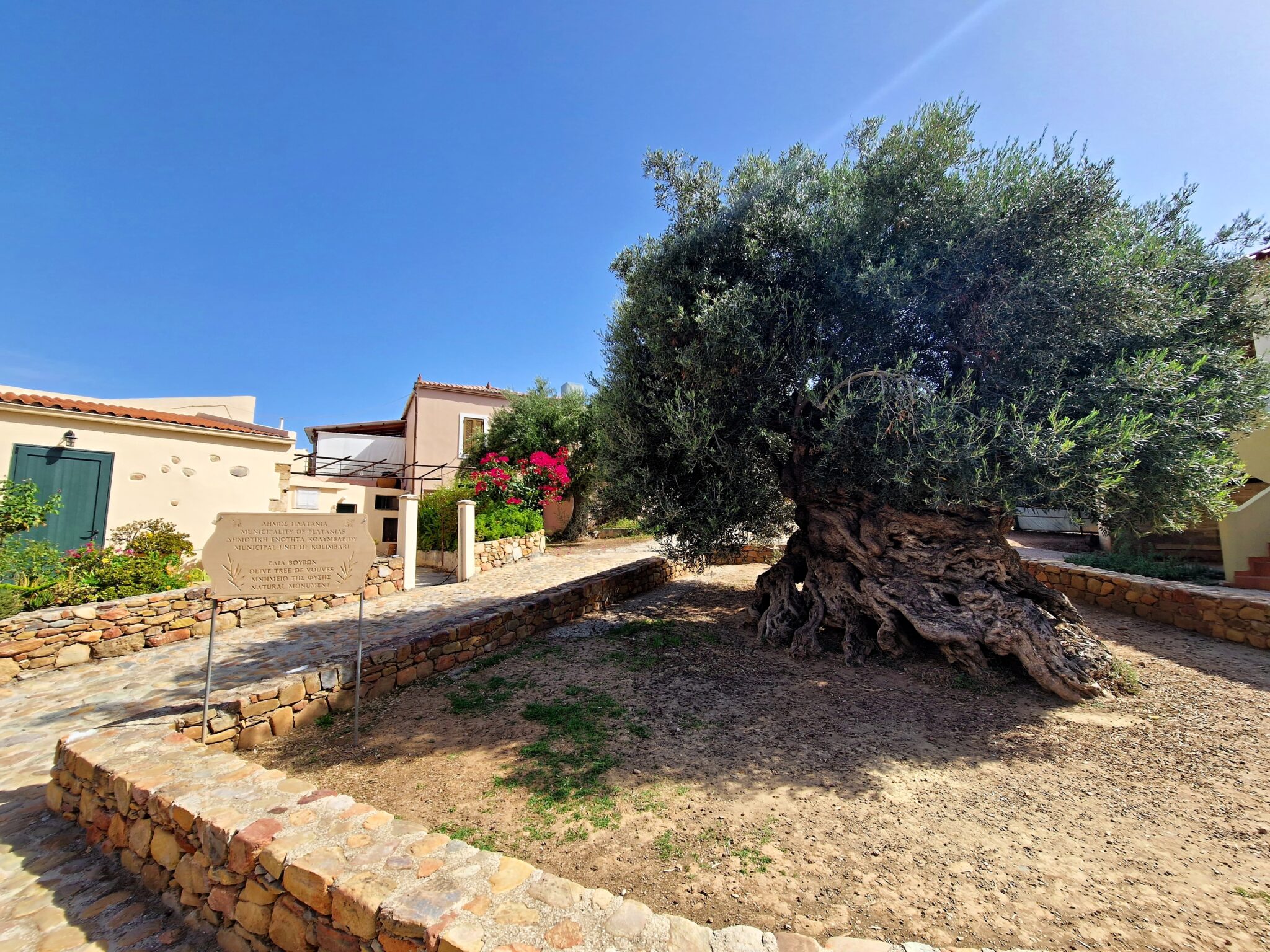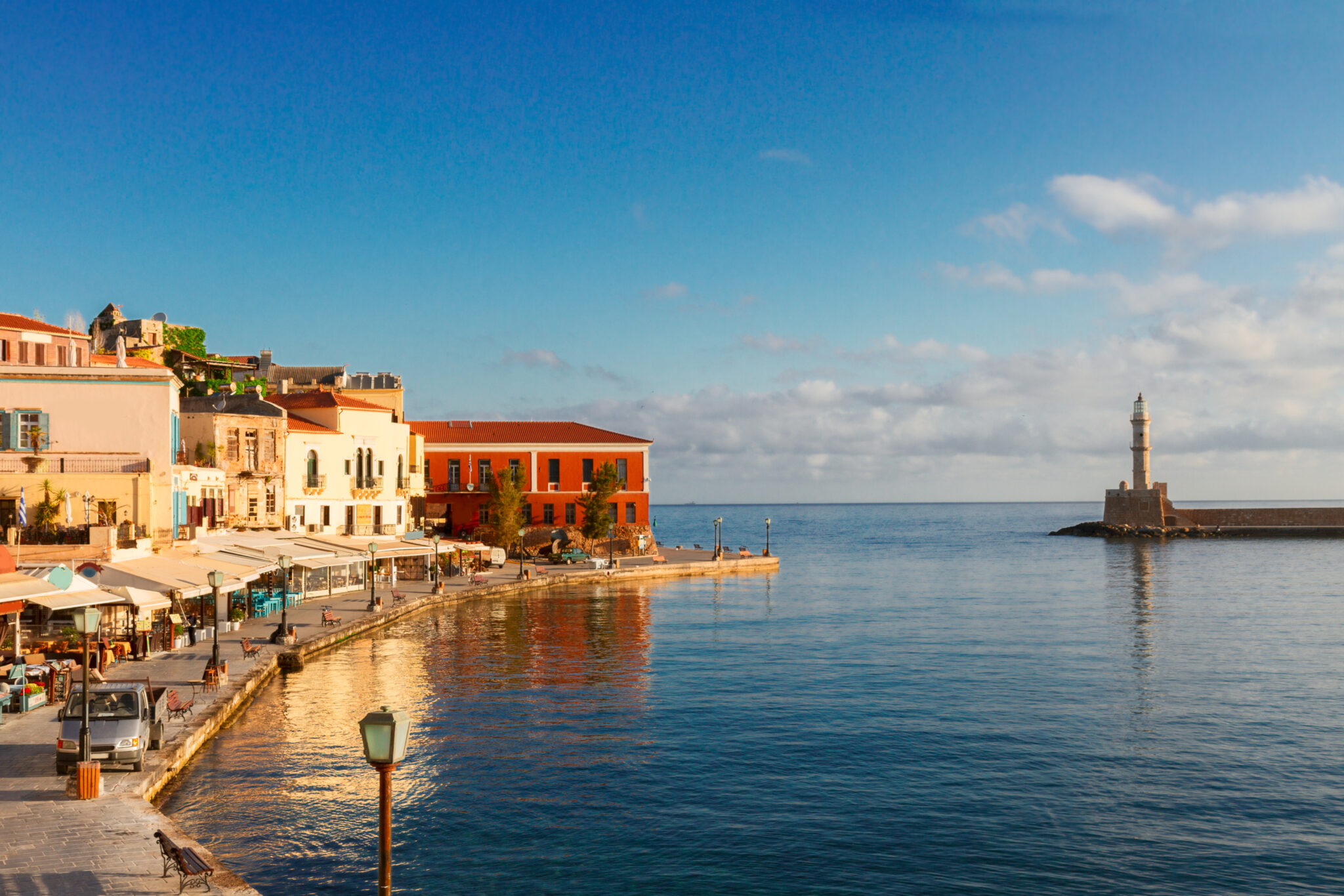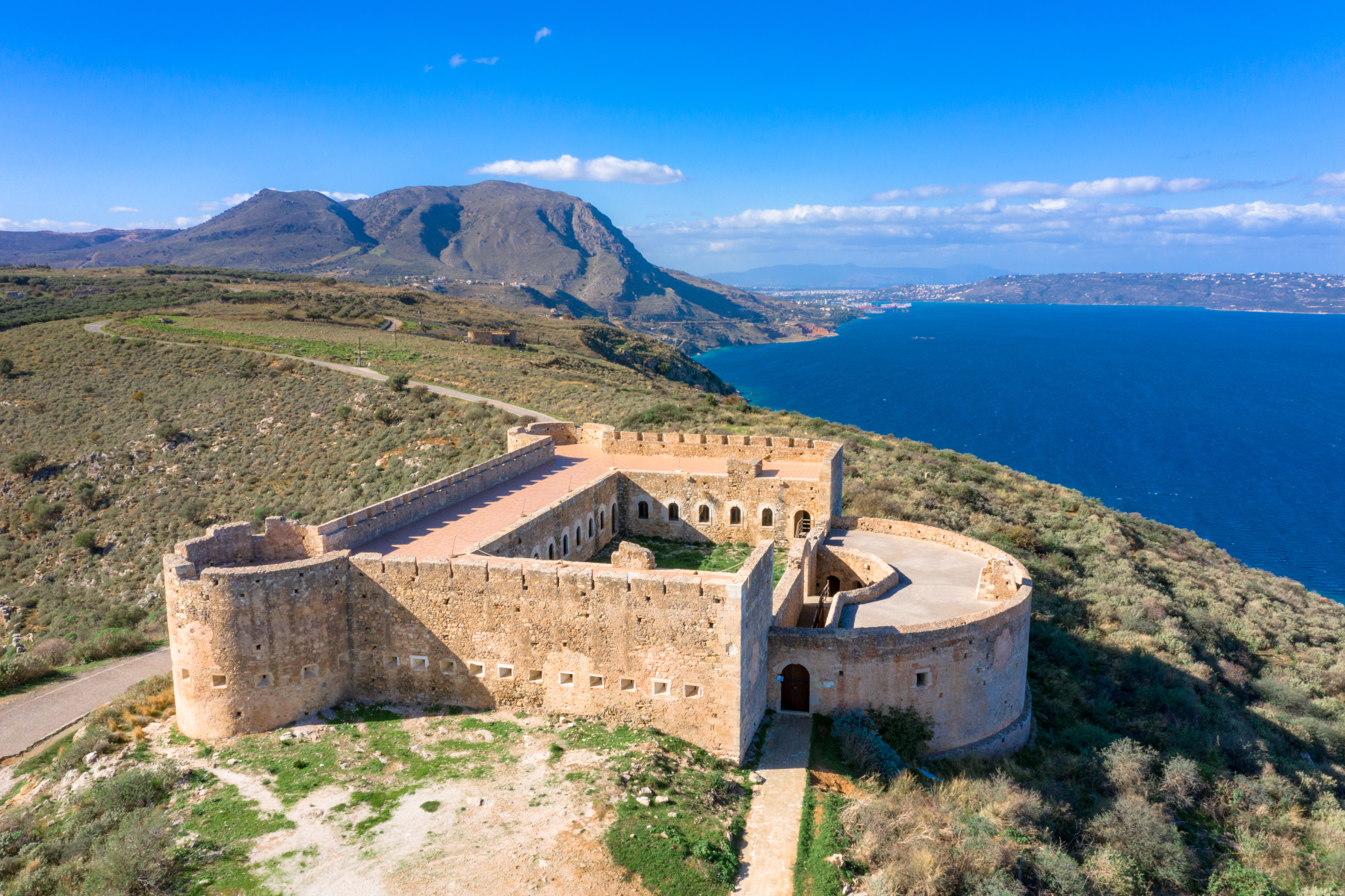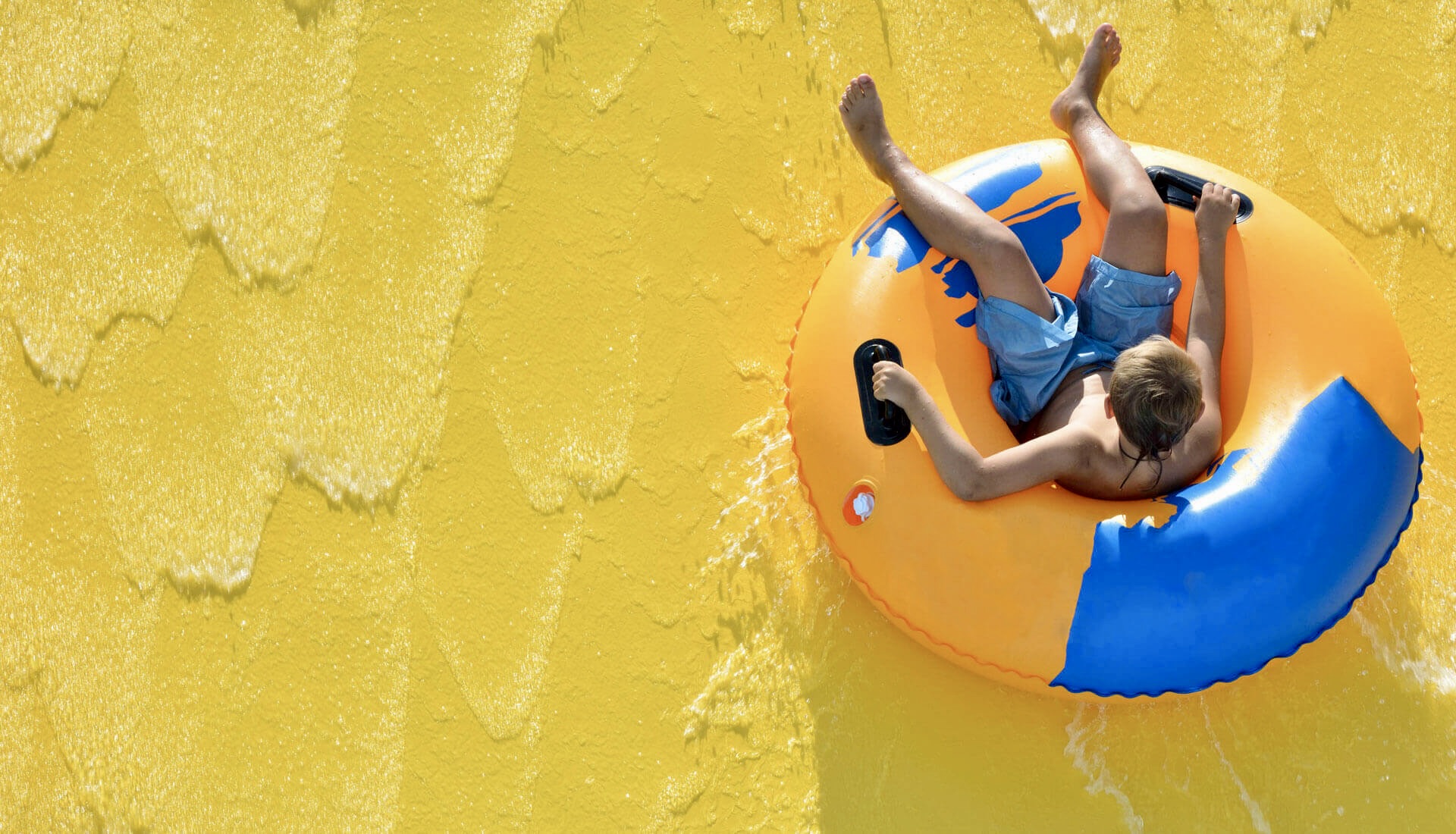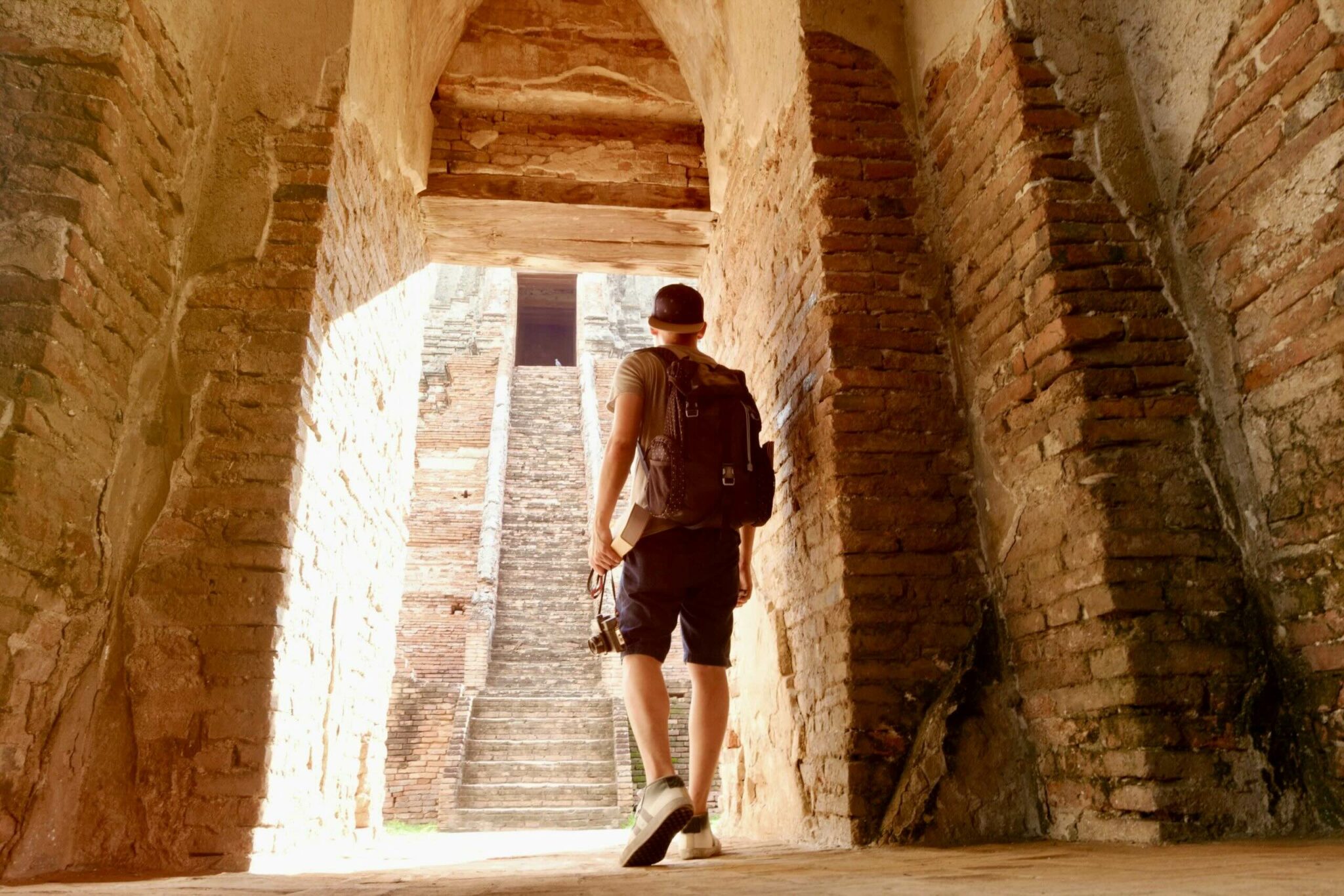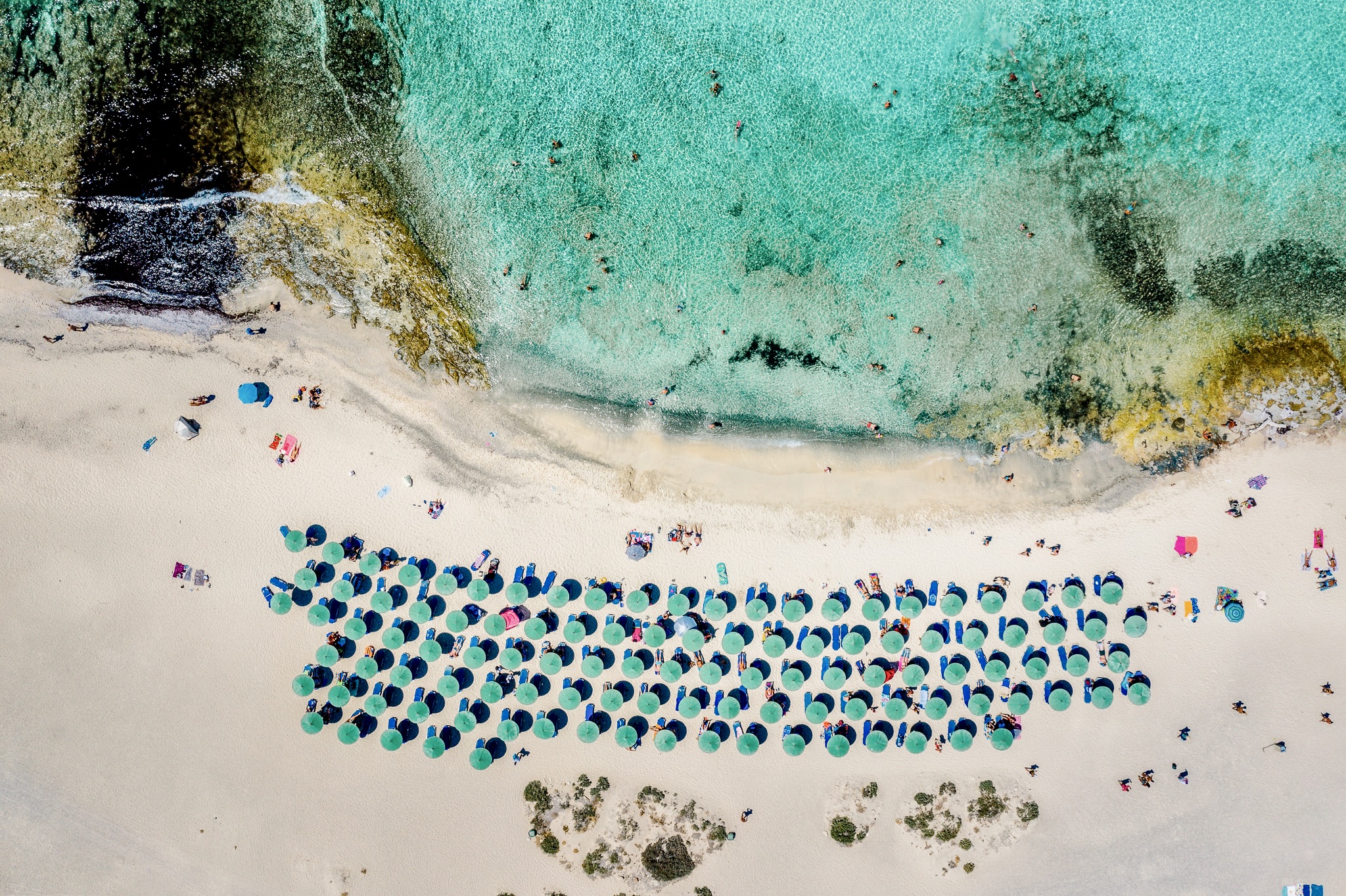The Terroir and the varieties
Chania, gracing the western tip of Crete, is marked by its awe-inspiring geographical centrepiece – the majestic Lefka Ori, or White Mountains. Reaching altitudes of up to 2000 metres, these peaks traverse the entirety of the region. This fascinating tapestry of Crete is punctuated by an abundance of vegetation, distinguishing it as the most refreshing part of the island. This verdant haven owes its existence to the unique interplay of the White Mountains and atmospheric conditions. On one hand, they ensnare the eastward air currents, giving rise to frequent showers. On the other, they serve as a natural barrier, staving off the searing summer heat, particularly in the northern region. It is here that the majority of the vineyards, benefiting from the northern orientation and the cooling summer Meltemi winds, find their home.
The primary portion of Chania’s vineyards is situated at altitudes between 200 and 500 meters to the west of the city. Yet the cultivation of grapes extends its tendrils to the sea level and elevations reaching up to 900 meters. Despite viticulture and winemaking in the region having ancient roots, organised grape farming and professional winemaking arrived late.
This could be attributed to the deeply entrenched tradition of household winemaking – almost every family owned a vineyard and produced its own wine, fulfilling a considerable portion of their needs. This tradition not only led to the preservation of many old vineyards that today produce wines of exceptional concentration and complexity, but also safeguarded the traditional style of Marouvas wine, which is by today being produced professionally.
Chania is the birthplace of the red Romeiko and the white Moschato Spinas grape varieties. Exceptional wines are also derived from international Rhone varieties like the reds Syrah, Grenache, Mourvèdre and the white Roussanne. Additionally, red Kotsifali and Mandilaria along with the whites Vilana, Thrapsathiri, Athiri, Assyrtiko, and Malvasia Aromatica are of particular interest.
Wines produced in the region of Chania can carry the Protected Geographical Indication (PGI) of either Chania or the broader PGI of Crete. The latter is typically used when part or all of the grapes originate from neighbouring regions. There is also a smaller PGI of Kissamos, a region where the Romeiko variety prevails. As of now, no Protected Designation of Origin (PDO) zones have been established.
Wineries and production methods
The Manousakis Winery, standing as a testament to one man’s enduring connection to his birthplace, was established by Theodore Manousakis on the fringe of Vatolakkos. While his life is based in the United States, the winery was Theodore’s homage to his origins. Nowadays, the torch is held high by his daughter Alexandra, who, having permanently settled in Chania, is devoted to the winery’s flourishing. Noted for their exceptional vigour and intricacy, their wines are crafted from varietals of the Rhône. Their pinnacle can be found within the “Nostos Blend”, a fusion of Syrah, Mourvèdre, Grenache Rouge, and Roussane, cultivated between altitudes of 320 to 600 meters. The “Nostos Romeiko” label is a Blanc de Noirs, a white wine birthed from the red grapes of the local Romeiko variety, resonating with vibrant acidity and bursting freshness. The “Nostos Pink”, a crisp rosé with a subtly sweet finish, was born from the marriage of Grenache Rouge, Romeiko, and Syrah varieties. The winery welcomes visitors.
Address: Vatolakkos Chania, tel.: +30 28210-78787, info@manousakiswinery.com, manousakiswinery.com.
In the Karavitakis Winery, chemistry and the art of winemaking converge. Established by chemist-winemaker Manolis Karavitakis, the tradition is now upheld by his son Nikos, also a chemist. Their private vineyards nurture both local Greek and international varieties. The contemporary winery is situated amidst vineyards and olive groves, crowning the hills of the Kolymbari region.
Among the estate’s labels, the “Elia Blend” in particular stands out. It is a robust blend of red Rhône varieties (Syrah, Grenache, Carignan) that matures from 11 to 14 months in French and American oak barrels. The “Kompsos Liatiko” is a light, fruity wine with pleasant hints of sweet spices, most enjoyable when served chilled alongside cheese dishes or pasta with red sauces. Lastly, the “Klima Vidiano” is a sophisticated and complex white wine from the local Vidiano variety, maturing in 500-litre oak barrels, porcelain amphoras, and stainless steel tanks. The winery welcomes visitors.
Address: Pontikiana Chania, tel.: +30 28240-23381, +30 6974 323852, info@karavitakiswines.com, karavitakiswines.com.
Founded in 1988 by Andreas Dourakis, the Dourakis Winery is located in Alikambos, at an altitude of 350 meters. The vineyards are planted on sloping, rocky soil between the Cretan Sea and the White Mountains’ slopes, with organic practices applied to their cultivation. The “Lihnos Vidiano” beautifully blends floral and lemony aromas, with subtle barreling adding vanilla hints.
Two distinctive wines are produced from the local Romeiko variety: the effervescent “Cassiopeia Romeiko” and the sweet “Euphoria Romeiko”. The former, produced in the Champagne method, offers a sparkling wine with fine bubbles, high acidity, and elegant floral aromas. The sweet version of Romeiko, made from sun-dried grapes, beguiles with rich citrus, honey, and butter caramel aromas. The winery welcomes visitors.
Address: Alikambos Apokoronas, Chania, tel.: +30 28250-51761, info@dourakiswin
Endochora Winery is a boutique establishment that produces a modest 10,000 bottles annually. Its vineyards, both private and located in the regions of Apokoronas and Kerameia in Chania, take centre stage. The vineyard’s patrons spotlight the local grape varieties, Kotsifali, Romeiko, and Vidiano, and additionally cultivate the international variety, Syrah. With limited yields, judicious interventions, and the application of organic practices in viticulture, they bring forth the uniqueness of their terroir. Their white wine, derived from the Vidiano grape, accentuates the fruity characteristics inherent to this Cretan variety. Its five-month stay with the lees lends it volume, aromatic complexity, and an unctuous texture. The red wine, made from the local Kotsifali variety, impresses with its robust body, red fruit aromas, and botanical notes, while Romeiko is vinified into a light and refreshing rosé wine.
Contact: Emmanouil Pimpli 7, Chania, tel: +30 6979698169, endochora.wines@gmail.com.
The Mamidakis family founded the Anoskeli Winery in 1983, situated in the village of Anoskeli, at an altitude of 260 meters, west of Chania. Besides viticulture and winemaking, the family also produces extra virgin olive oil from the Koroneiki olive. The white wine “Ano Plagia” is born from the marriage of the Assyrtiko and Malagouzia varieties and pairs excellently with seafood and fresh salads. The label “200” is an anniversary label of the winery, honoring the 200 years since the Greek Revolution. It is a monovarietal white wine from Assyrtiko, boasting high acidity and a buttery aftertaste. The “Stone Wine” is a red wine circulated in just 300 bottles annually. It is produced from five different harvests of the Romeiko variety, rendering complex flavours of red fruits and caramel. The company operates as a visitable winery and oil mill.
Address: Anoskeli, Platanias, Chania, tel: +30 28240-83126-127, info@anoskeli.gr, anoskeli.gr.
Loupaki Estate situates itself in the semi-mountainous region of the Municipality of Platanias, proudly occupying the apex of Gra Lygia hill. It revels in the shade offered by the White Mountains, its gaze drawn to the expansive Cretan Sea. Carrying forward a cherished family tradition, siblings Miltiadis and Aspasia Loupaki have taken the helm, evolving the winery into a model of modern production, responsible for crafting, standardising, and trading wine. Winemaker Miltiadis Loupakis nurtures the family vineyards, a 15-acre haven filled with the Vilana, Kotsifali, Mantilari, and Cabernet Sauvignon varieties. Among the standout labels from the estate are the “Red Summit”, a Cabernet Sauvignon, maturing gracefully over 12 months in oak barrels, the “Red Caress”, a fresh rendition of the local variety, and the “White Caress”, a cool and fresh wine made from the Vilana variety. The winery welcomes visitors by appointment only.
Address: Village of Kares, Municipality of Platanias, Chania, phone: +30 6945266287, loupaki.aspasia@gmail.com.
The Pateromichelaki Winery carries a tradition beginning in the second half of the 1800s, where local varieties such as Romeiko, Liatiko and Moschato Spinas were cultivated on a 25-acre expanse. The invasion of phylloxera (which devastated grape production) in 1930 led them to shift their focus to olive oil production, and they returned to winemaking for the second time in 2007. Brothers Manolis and Giannis, in a single 55-acre vineyard, cultivate Romeiko, Mavrotragano, Syrah, Assyrtiko and Moschato Spinas grapes following organic practices. The winery and the oil mill are built on the very site where the family’s first winery operated. The estate’s richly aged Mavrotragano, the elegantly subtle red Romeiko and the cool white (Blanc de Noirs) Romeiko distinguish themselves among the labels. Vineyard tours are available by prior arrangement.
Address: Lousakies of Kissamos, Chania, phone: +30 6977434183, info@pateromichelakis.gr, pateromichelakis.gr.
Sights and points of interest on the wine routes of the region
The tasting experience in the Chania region is enhanced by the intriguing nearby attractions including Askifou and Lake Kournas, the Botanical Park of Crete, Ano Vouves with its monumental olive tree, the Archaeological Museum of Kissamos, and the significant archaeological site of Aptera.
Askifou and Lake Kournas: Located south of the Dourakis winery in the Sfakia region, you’ll find the plateau and the five hamlets of Askifou enveloped by the White Mountains. In the Kare village, the War Museum hosts a collection of wartime artefacts from 1940-44, meticulously gathered by Georgios Chatzidakis, resulting in a collection of over 2,000 exhibits. To the east of the winery, Lake Kournas provides a crucial wetland habitat for the island’s wildlife, home to ducks, eels, water turtles, goldfish, and migratory birds. There are several taverns offering a splendid lake view, and options to swim or hire paddle boats and canoes.
Botanical Park of Crete: Close to the Manousakis winery lies this unique 200-acre park. Traverse the pathways, appreciating the multitude of herbs, medicinal and ornamental plants, flowers, and fruit trees from all corners of the globe. The park also features a lake filled with water birds and a restaurant (www.botanical-park.com).
Vouves: Near the Karavitakis, Loupakis, and Anoskeli wineries (30 km from Chania), you’ll discover Ano Vouves, home to the oldest recorded olive tree in the world. This natural monument has an estimated age of 3-5,000 years, its trunk resembling a work of art. In 2004 Olympics, a wreath from this olive tree was used to crown the winner of the marathon. Adjacent to the tree, the Olive Museum exhibits a range of olive-related artefacts, including a primitive plough often referred to as the “Hesiodic plough”.
The Archaeological Museum of Kissamos: While visiting the Pateromichelaki winery, this modest yet engaging museum is worth a detour. Located within the “Governor’s Office”, it offers glimpses into the region’s history from prehistoric to late antiquity, featuring a notable collection of Hellenistic and Roman urban mansions.
The greater winery area offers more attractions, including the Venetian town of Chania. Seaside resorts on the north coast, west of Chania, cater to tourists and Platanias, closest to the city, is especially popular.
Aptera: A short drive east of Chania brings you to the archaeological site of Aptera, offering breath-taking views over Souda Bay. A major city-state of Crete, it thrived during the Classical and Hellenistic periods when temples, theatres, and fortifications were constructed, and flourished again during the Roman era (69 BC-365 AD), with the erection of impressive public buildings. The site, centred around the early 16th-century Monastery of Saint John the Theologian, features the temple of Apollo and Artemis, a theatre, Roman cisterns, baths, and the so-called “Bouleuterion” Building of the Council.




